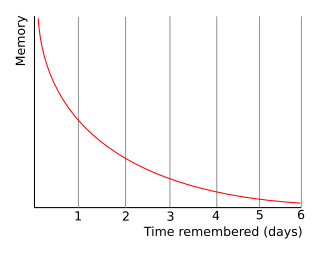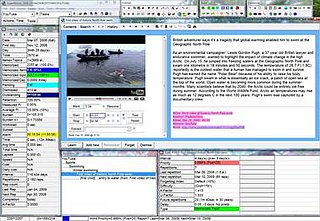
The forgetting curve hypothesizes the decline of memory retention in time. This curve shows how information is lost over time when there is no attempt to retain it. A related concept is the strength of memory that refers to the durability that memory traces in the brain. The stronger the memory, the longer period of time that a person is able to recall it. A typical graph of the forgetting curve purports to show that humans tend to halve their memory of newly learned knowledge in a matter of days or weeks unless they consciously review the learned material.

Spaced repetition is an evidence-based learning technique that is usually performed with flashcards. Newly introduced and more difficult flashcards are shown more frequently, while older and less difficult flashcards are shown less frequently in order to exploit the psychological spacing effect. The use of spaced repetition has been proven to increase the rate of learning.

SuperMemo is a learning method and software package developed by SuperMemo World and SuperMemo R&D with Piotr Woźniak in Poland from 1985 to the present. It is based on research into long-term memory, and is a practical application of the spaced repetition learning method that has been proposed for efficient instruction by a number of psychologists as early as in the 1930s.

A mnemonic device or memory device is any learning technique that aids information retention or retrieval in the human memory, often by associating the information with something that is easier to remember.

Rote learning is a memorization technique based on repetition. The method rests on the premise that the recall of repeated material becomes faster the more one repeats it. Some of the alternatives to rote learning include meaningful learning, associative learning, spaced repetition and active learning.
Memorization is the process of committing something to memory. It is a mental process undertaken in order to store in memory for later recall visual, auditory, or tactical information.

A flashcard or flash card is a card bearing information on both sides, which is intended to be used as an aid in memorization. Each flashcard typically bears a question or definition on one side and an answer or target term on the other. Flashcards are often used to memorize vocabulary, historical dates, formulae or any subject matter that can be learned via a question-and-answer format. Flashcards can be virtual, or physical.

The testing effect suggests long-term memory is increased when part of the learning period is devoted to retrieving information from memory. It is different from the more general practice effect, defined in the APA Dictionary of Psychology as "any change or improvement that results from practice or repetition of task items or activities."
Linkword is a mnemonic system promoted by Michael Gruneberg since at least the early 1980s for learning languages based on the similarity of the sounds of words. The process involves creating an easily visualized scene that will link the words together. One example is the Russian word for cow : think and visualize "I ran my car over a cow."
Kinesthetic learning, kinaesthetic learning, or tactile learning is learning that involves physical activity. As cited by Favre (2009), Dunn and Dunn define kinesthetic learners as students who prefer whole-body movement to process new and difficult information. However, scientific studies do not support the claim that using kinesthetic modality improves learning in students identified as kinesthetic learning as their preferred learning style.
This is an index of education articles.

Study skills or study strategies are approaches applied to learning. Study skills are an array of skills which tackle the process of organizing and taking in new information, retaining information, or dealing with assessments. They are discrete techniques that can be learned, usually in a short time, and applied to all or most fields of study. More broadly, any skill which boosts a person's ability to study, retain and recall information which assists in and passing exams can be termed a study skill, and this could include time management and motivational techniques.
The audio-lingual method or Army Method is a method used in teaching foreign languages. It is based on behaviorist theory, which postulates that certain traits of living things, and in this case humans, could be trained through a system of reinforcement. The correct use of a trait would receive positive while incorrect use of that trait would receive negative feedback.

The Leitner system is a widely used method of efficiently using flashcards that was proposed by the German science journalist Sebastian Leitner in 1972. It is a simple implementation of the principle of spaced repetition, where cards are reviewed at increasing intervals.

Mnemosyne is a line of spaced repetition software developed since 2003. Spaced repetition is an evidence-based learning technique that has been shown to increase the rate of memorization.

David Andrew Farrow is a two-time Canadian Guinness World Record Holder for Most Decks of Playing Cards Memorized in a Single Sighting, entrepreneur, memory coach, speed reader and keynote speaker. He is best known for winning the Guinness World Records for Most Decks of Playing Cards Memorized in a Single Sighting in 1996 and again in 2007 when he set out to reclaim his record after it was beaten in 2002. The initial record was set at the Guinness World Records museum in Niagara Falls, Ontario, Canada while the latter was performed for Discovery Channel Canada at CTV Television Network studios. Both records were accomplished under the controlled supervision of multiple cameras and multiple independent witnesses.
Distributed practice is a learning strategy, where practice is broken up into a number of short sessions over a longer period of time. Humans and other animals learn items in a list more effectively when they are studied in several sessions spread out over a long period of time, rather than studied repeatedly in a short period of time, a phenomenon called the spacing effect. The opposite, massed practice, consists of fewer, longer training sessions and is generally a less effective method of learning. For example, when studying for an exam, dispersing your studying more frequently over a larger period of time will result in more effective learning than intense study the night before.
Elaborative encoding is a mnemonic system that uses some form of elaboration, such as an emotional cue, to assist in the retention of memories and knowledge. In this system one attaches an additional piece of information to a memory task which makes it easier to recall. For instance, one may recognize a face easier if character traits are also imparted about the person at the same time.
A desirable difficulty is a learning task that requires a considerable but desirable amount of effort, thereby improving long-term performance. It is also described as a learning level achieved through a sequence of learning tasks and feedback that lead to enhanced learning and transfer.
Active student response (ASR) techniques are strategies to elicit observable responses from students in a classroom. They are grounded in the field of behavioralism and operate by increasing opportunities reinforcement during class time, typically in the form of instructor praise. Active student response techniques are designed so that student behavior, such as responding aloud to a question, is quickly followed by reinforcement if correct. Common form of active student response techniques are choral responding, response cards, guided notes, and clickers. While they are commonly used for disabled populations, these strategies can be applied at many different levels of education. Implementing active student response techniques has been shown to increase learning, but may require extra supplies or preparation by the instructor.








